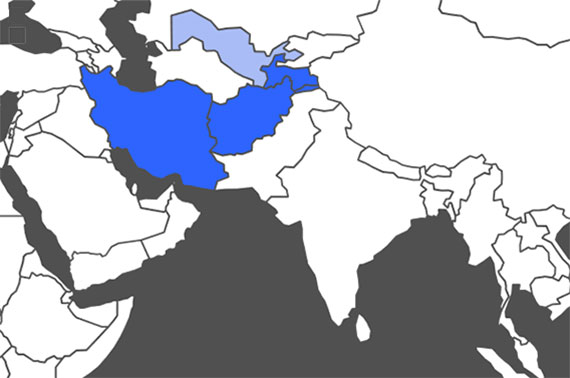The Persian program in the Indiana University Department of Central Eurasian Studies (CEUS) offers students a great opportunity to learn an ancient language of politics and culture, a language now spoken by over 100 million people in Iran, Afghanistan, and Central Asia.
Persian language study at IU

Every year, we offer introductory, intermediate, and advanced Persian classes taught by the IU Senior Lecturer in Persian.
During the summer, Language Workshop offers courses in Persian.
Persian language learning as part of the CEUS undergraduate major and minor
Persian is one of the languages available for the CEUS undergraduate major. Tracks with two or three years of language study are available.
Fulfill your foreign language requirement in a small class with dedicated teachers. You can also receive a CEUS minor with two years of Persian language study and a related culture course.
IU Course Offerings:
Course offerings are made available in accordance with class level and student interest. Several IAUNRC languages - including Persian - are part of IU’s Summer Language Workshop.
Why study Persian?
Every day, there’s news from Iran or Afghanistan on TV, radio, newspapers, and the web. To really understand events that are shaping the world today, learn Persian: the official language of Iran and Afghanistan.
Persian is the easiest Middle Eastern language for English speakers to learn. Knowledge of Persian will help you learn Turkic, Arabic, Urdu, Hindi, and other languages and pursue a variety of exciting careers in government, international business, or education.
Long before French or English, Persian was the international language. Architecture, music, novels, and paintings: Persian language is the key to the beauties of medieval Persian culture–and a vibrant modern culture as well.
Iranian film makers are pushing the boundaries with some of the most exciting movies in modern times. The challenging ideas of Iran’s modern intellectuals have been shaping reform and revolution throughout the whole Muslim and developing world.
Persian Alphabet
ا alif h á, a arm, cat
ب bá f b b
پ pá p p p
ت tá j t t
ث thá e th see
ج jím [ j john
چ ch c ch church
ح há p h h
خ khá o kh loch
د dál ] d d
ذ dhál ` dh z
ر rá v r r
ز záy . z z
ژ zh . zh pleasure
س sín s s so
ش shín a sh she
ص sád w s. so
ض dád q d. z
ط tá ' t. t
ظ zá / z. z
ع 'ayn u ' silent "uh"
غ ghayn y gh get
ف fá t f f
ق qáf r q get
ک káf ; k k
گ g g g get
ل lám g l l
م mím l m m
ن nún k n n
و waw , v, ú v, oo v, oo
ه há i h h
ی yá d y, í yes, ee yes, ee
ء hamza x ' silent "uh"
What is Persian?
There are a number of lexical, phonological, and syntactic differences and nuances that distinguish Dari from Farsi and Tajiki. These variations include the following:
The use of certain tenses. For example, while Farsi uses the auxiliary verb dāštan ‘to have’ and Tajiki uses istādan ‘to stay’ to form the present and past continuous tenses, Dari does not employ any auxiliary verbs. It simply uses the habitual tense in combination with appropriate adverbs.
Lexical differences. For example: ‘chair’–čawkí in Dari, but sandal in Farsi, and stul (Russian loanword) in Tajiki. ‘notebook’–kitābča in Dari, but daftar in Farsi and Tajiki (daftar means ‘office’ in Dari).
Additionally, each language has loanwords from neighboring languages.
However, all three, Farsi, Dari, and Tajiki, do share some main linguistic features, some of these include: SOV word order, agglutination, no grammatical gender, and null-subject.
Common Phrases:
Audio transcript:
Salam!
Hello!
Audio transcript:
Ismi farsi-e-man Hafiz ast.
My Farsi name is Hafiz.
Audio transcript:
Khuda Hafez.
Take care! (Goodbye!)


